Haneul Yoo
On the Effect of Uncertainty on Layer-wise Inference Dynamics
Jul 09, 2025Abstract:Understanding how large language models (LLMs) internally represent and process their predictions is central to detecting uncertainty and preventing hallucinations. While several studies have shown that models encode uncertainty in their hidden states, it is underexplored how this affects the way they process such hidden states. In this work, we demonstrate that the dynamics of output token probabilities across layers for certain and uncertain outputs are largely aligned, revealing that uncertainty does not seem to affect inference dynamics. Specifically, we use the Tuned Lens, a variant of the Logit Lens, to analyze the layer-wise probability trajectories of final prediction tokens across 11 datasets and 5 models. Using incorrect predictions as those with higher epistemic uncertainty, our results show aligned trajectories for certain and uncertain predictions that both observe abrupt increases in confidence at similar layers. We balance this finding by showing evidence that more competent models may learn to process uncertainty differently. Our findings challenge the feasibility of leveraging simplistic methods for detecting uncertainty at inference. More broadly, our work demonstrates how interpretability methods may be used to investigate the way uncertainty affects inference.
HERITAGE: An End-to-End Web Platform for Processing Korean Historical Documents in Hanja
Jan 21, 2025



Abstract:While Korean historical documents are invaluable cultural heritage, understanding those documents requires in-depth Hanja expertise. Hanja is an ancient language used in Korea before the 20th century, whose characters were borrowed from old Chinese but had evolved in Korea for centuries. Modern Koreans and Chinese cannot understand Korean historical documents without substantial additional help, and while previous efforts have produced some Korean and English translations, this requires in-depth expertise, and so most of the documents are not translated into any modern language. To address this gap, we present HERITAGE, the first open-source Hanja NLP toolkit to assist in understanding and translating the unexplored Korean historical documents written in Hanja. HERITAGE is a web-based platform providing model predictions of three critical tasks in historical document understanding via Hanja language models: punctuation restoration, named entity recognition, and machine translation (MT). HERITAGE also provides an interactive glossary, which provides the character-level reading of the Hanja characters in modern Korean, as well as character-level English definition. HERITAGE serves two purposes. First, anyone interested in these documents can get a general understanding from the model predictions and the interactive glossary, especially MT outputs in Korean and English. Second, since the model outputs are not perfect, Hanja experts can revise them to produce better annotations and translations. This would boost the translation efficiency and potentially lead to most of the historical documents being translated into modern languages, lowering the barrier on unexplored Korean historical documents.
When Does Classical Chinese Help? Quantifying Cross-Lingual Transfer in Hanja and Kanbun
Nov 07, 2024



Abstract:Historical and linguistic connections within the Sinosphere have led researchers to use Classical Chinese resources for cross-lingual transfer when processing historical documents from Korea and Japan. In this paper, we question the assumption of cross-lingual transferability from Classical Chinese to Hanja and Kanbun, the ancient written languages of Korea and Japan, respectively. Our experiments across machine translation, named entity recognition, and punctuation restoration tasks show minimal impact of Classical Chinese datasets on language model performance for ancient Korean documents written in Hanja, with performance differences within $\pm{}0.0068$ F1-score for sequence labeling tasks and up to $+0.84$ BLEU score for translation. These limitations persist consistently across various model sizes, architectures, and domain-specific datasets. Our analysis reveals that the benefits of Classical Chinese resources diminish rapidly as local language data increases for Hanja, while showing substantial improvements only in extremely low-resource scenarios for both Korean and Japanese historical documents. These mixed results emphasize the need for careful empirical validation rather than assuming benefits from indiscriminate cross-lingual transfer.
Code-Switching Curriculum Learning for Multilingual Transfer in LLMs
Nov 04, 2024



Abstract:Large language models (LLMs) now exhibit near human-level performance in various tasks, but their performance drops drastically after a handful of high-resource languages due to the imbalance in pre-training data. Inspired by the human process of second language acquisition, particularly code-switching (the practice of language alternation in a conversation), we propose code-switching curriculum learning (CSCL) to enhance cross-lingual transfer for LLMs. CSCL mimics the stages of human language learning by progressively training models with a curriculum consisting of 1) token-level code-switching, 2) sentence-level code-switching, and 3) monolingual corpora. Using Qwen 2 as our underlying model, we demonstrate the efficacy of the CSCL in improving language transfer to Korean, achieving significant performance gains compared to monolingual continual pre-training methods. Ablation studies reveal that both token- and sentence-level code-switching significantly enhance cross-lingual transfer and that curriculum learning amplifies these effects. We also extend our findings into various languages, including Japanese (high-resource) and Indonesian (low-resource), and using two additional models (Gemma 2 and Phi 3.5). We further show that CSCL mitigates spurious correlations between language resources and safety alignment, presenting a robust, efficient framework for more equitable language transfer in LLMs. We observe that CSCL is effective for low-resource settings where high-quality, monolingual corpora for language transfer are hardly available.
LLM-Driven Learning Analytics Dashboard for Teachers in EFL Writing Education
Oct 19, 2024
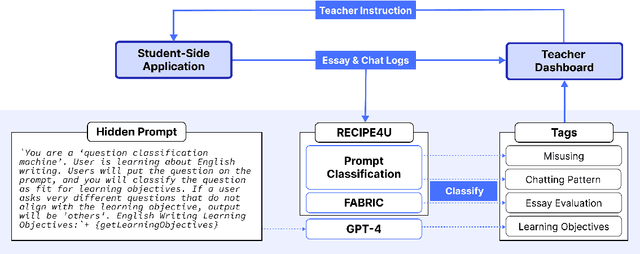
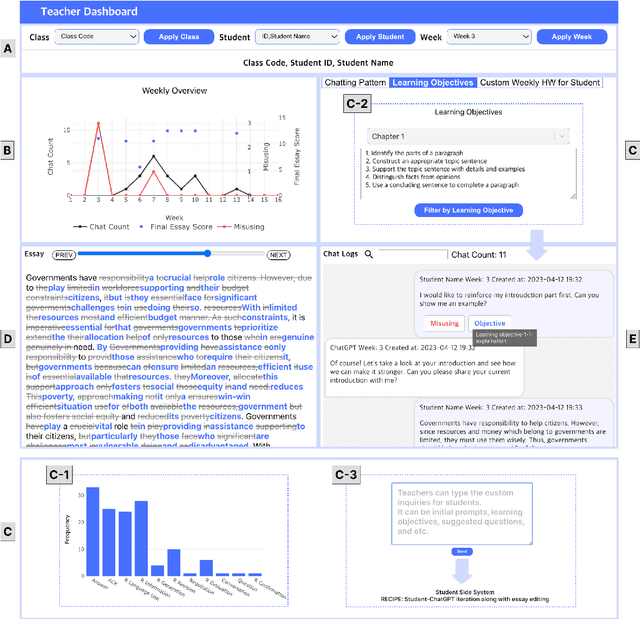
Abstract:This paper presents the development of a dashboard designed specifically for teachers in English as a Foreign Language (EFL) writing education. Leveraging LLMs, the dashboard facilitates the analysis of student interactions with an essay writing system, which integrates ChatGPT for real-time feedback. The dashboard aids teachers in monitoring student behavior, identifying noneducational interaction with ChatGPT, and aligning instructional strategies with learning objectives. By combining insights from NLP and Human-Computer Interaction (HCI), this study demonstrates how a human-centered approach can enhance the effectiveness of teacher dashboards, particularly in ChatGPT-integrated learning.
MAQA: Evaluating Uncertainty Quantification in LLMs Regarding Data Uncertainty
Aug 13, 2024Abstract:Although large language models (LLMs) are capable of performing various tasks, they still suffer from producing plausible but incorrect responses. To improve the reliability of LLMs, recent research has focused on uncertainty quantification to predict whether a response is correct or not. However, most uncertainty quantification methods have been evaluated on questions requiring a single clear answer, ignoring the existence of data uncertainty that arises from irreducible randomness. Instead, these methods only consider model uncertainty, which arises from a lack of knowledge. In this paper, we investigate previous uncertainty quantification methods under the presence of data uncertainty. Our contributions are two-fold: 1) proposing a new Multi-Answer Question Answering dataset, MAQA, consisting of world knowledge, mathematical reasoning, and commonsense reasoning tasks to evaluate uncertainty quantification regarding data uncertainty, and 2) assessing 5 uncertainty quantification methods of diverse white- and black-box LLMs. Our findings show that entropy and consistency-based methods estimate the model uncertainty well even under data uncertainty, while other methods for white- and black-box LLMs struggle depending on the tasks. Additionally, methods designed for white-box LLMs suffer from overconfidence in reasoning tasks compared to simple knowledge queries. We believe our observations will pave the way for future work on uncertainty quantification in realistic setting.
CSRT: Evaluation and Analysis of LLMs using Code-Switching Red-Teaming Dataset
Jun 17, 2024



Abstract:Recent studies in large language models (LLMs) shed light on their multilingual ability and safety, beyond conventional tasks in language modeling. Still, current benchmarks reveal their inability to comprehensively evaluate them and are excessively dependent on manual annotations. In this paper, we introduce code-switching red-teaming (CSRT), a simple yet effective red-teaming technique that simultaneously tests multilingual understanding and safety of LLMs. We release the CSRT dataset, which comprises 315 code-switching queries combining up to 10 languages and eliciting a wide range of undesirable behaviors. Through extensive experiments with ten state-of-the-art LLMs, we demonstrate that CSRT significantly outperforms existing multilingual red-teaming techniques, achieving 46.7% more attacks than existing methods in English. We analyze the harmful responses toward the CSRT dataset concerning various aspects under ablation studies with 16K samples, including but not limited to scaling laws, unsafe behavior categories, and input conditions for optimal data generation. Additionally, we validate the extensibility of CSRT, by generating code-switching attack prompts with monolingual data.
HyperCLOVA X Technical Report
Apr 13, 2024Abstract:We introduce HyperCLOVA X, a family of large language models (LLMs) tailored to the Korean language and culture, along with competitive capabilities in English, math, and coding. HyperCLOVA X was trained on a balanced mix of Korean, English, and code data, followed by instruction-tuning with high-quality human-annotated datasets while abiding by strict safety guidelines reflecting our commitment to responsible AI. The model is evaluated across various benchmarks, including comprehensive reasoning, knowledge, commonsense, factuality, coding, math, chatting, instruction-following, and harmlessness, in both Korean and English. HyperCLOVA X exhibits strong reasoning capabilities in Korean backed by a deep understanding of the language and cultural nuances. Further analysis of the inherent bilingual nature and its extension to multilingualism highlights the model's cross-lingual proficiency and strong generalization ability to untargeted languages, including machine translation between several language pairs and cross-lingual inference tasks. We believe that HyperCLOVA X can provide helpful guidance for regions or countries in developing their sovereign LLMs.
CLIcK: A Benchmark Dataset of Cultural and Linguistic Intelligence in Korean
Mar 15, 2024Abstract:Despite the rapid development of large language models (LLMs) for the Korean language, there remains an obvious lack of benchmark datasets that test the requisite Korean cultural and linguistic knowledge. Because many existing Korean benchmark datasets are derived from the English counterparts through translation, they often overlook the different cultural contexts. For the few benchmark datasets that are sourced from Korean data capturing cultural knowledge, only narrow tasks such as bias and hate speech detection are offered. To address this gap, we introduce a benchmark of Cultural and Linguistic Intelligence in Korean (CLIcK), a dataset comprising 1,995 QA pairs. CLIcK sources its data from official Korean exams and textbooks, partitioning the questions into eleven categories under the two main categories of language and culture. For each instance in CLIcK, we provide fine-grained annotation of which cultural and linguistic knowledge is required to answer the question correctly. Using CLIcK, we test 13 language models to assess their performance. Our evaluation uncovers insights into their performances across the categories, as well as the diverse factors affecting their comprehension. CLIcK offers the first large-scale comprehensive Korean-centric analysis of LLMs' proficiency in Korean culture and language.
RECIPE4U: Student-ChatGPT Interaction Dataset in EFL Writing Education
Mar 13, 2024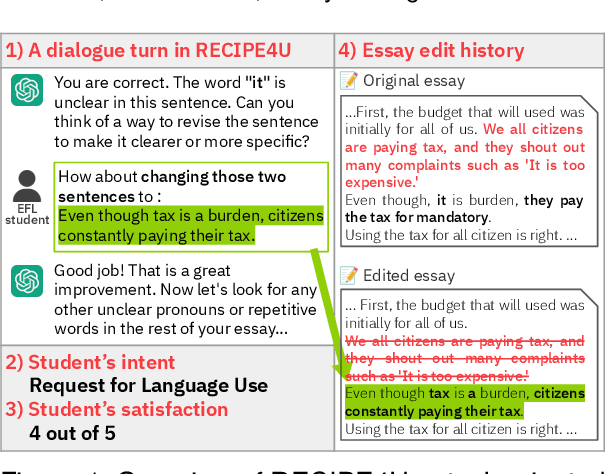
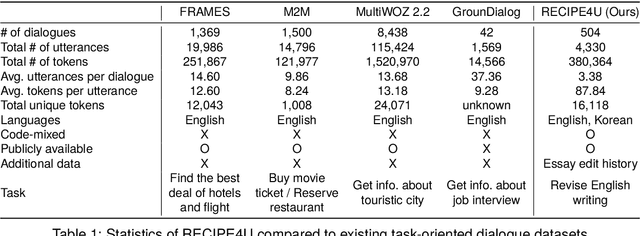
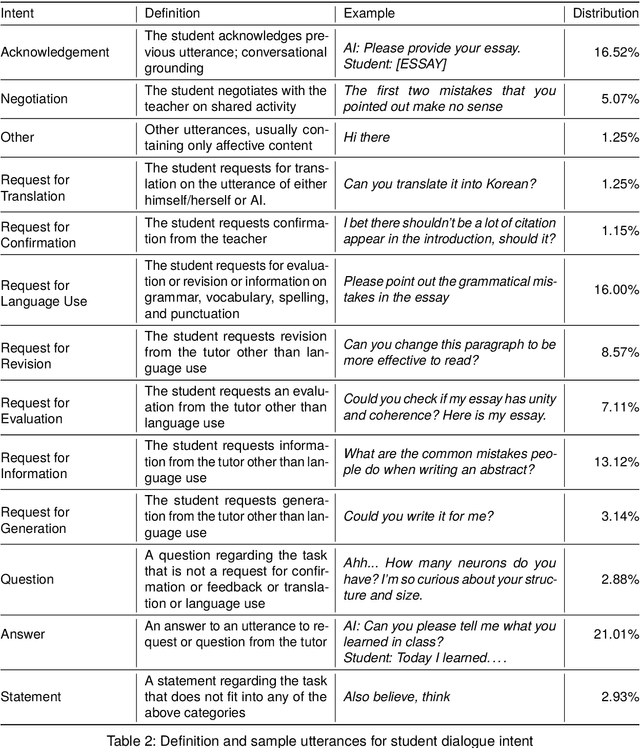
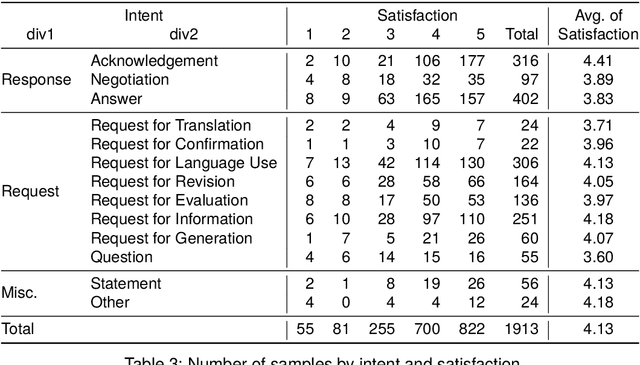
Abstract:The integration of generative AI in education is expanding, yet empirical analyses of large-scale and real-world interactions between students and AI systems still remain limited. Addressing this gap, we present RECIPE4U (RECIPE for University), a dataset sourced from a semester-long experiment with 212 college students in English as Foreign Language (EFL) writing courses. During the study, students engaged in dialogues with ChatGPT to revise their essays. RECIPE4U includes comprehensive records of these interactions, including conversation logs, students' intent, students' self-rated satisfaction, and students' essay edit histories. In particular, we annotate the students' utterances in RECIPE4U with 13 intention labels based on our coding schemes. We establish baseline results for two subtasks in task-oriented dialogue systems within educational contexts: intent detection and satisfaction estimation. As a foundational step, we explore student-ChatGPT interaction patterns through RECIPE4U and analyze them by focusing on students' dialogue, essay data statistics, and students' essay edits. We further illustrate potential applications of RECIPE4U dataset for enhancing the incorporation of LLMs in educational frameworks. RECIPE4U is publicly available at https://zeunie.github.io/RECIPE4U/.
 Add to Chrome
Add to Chrome Add to Firefox
Add to Firefox Add to Edge
Add to Edge